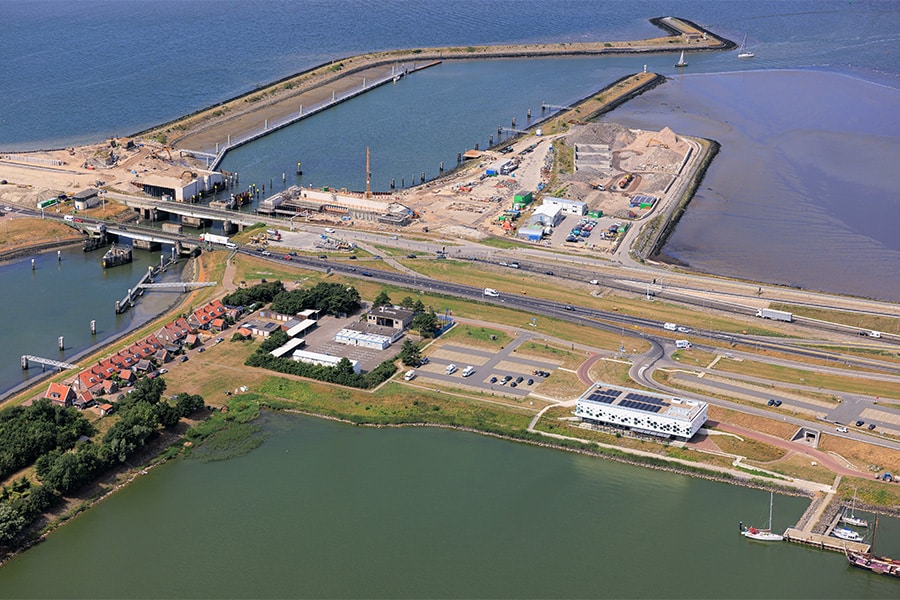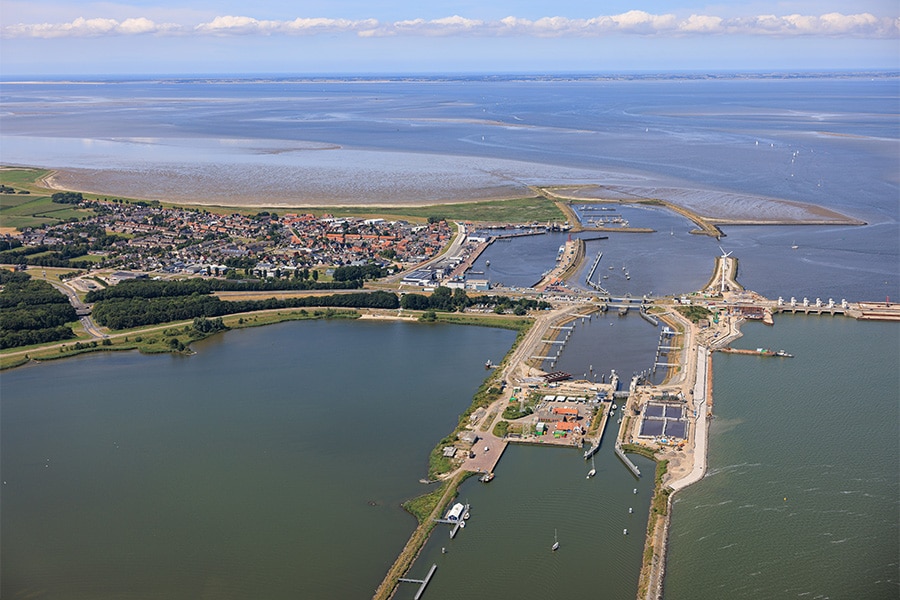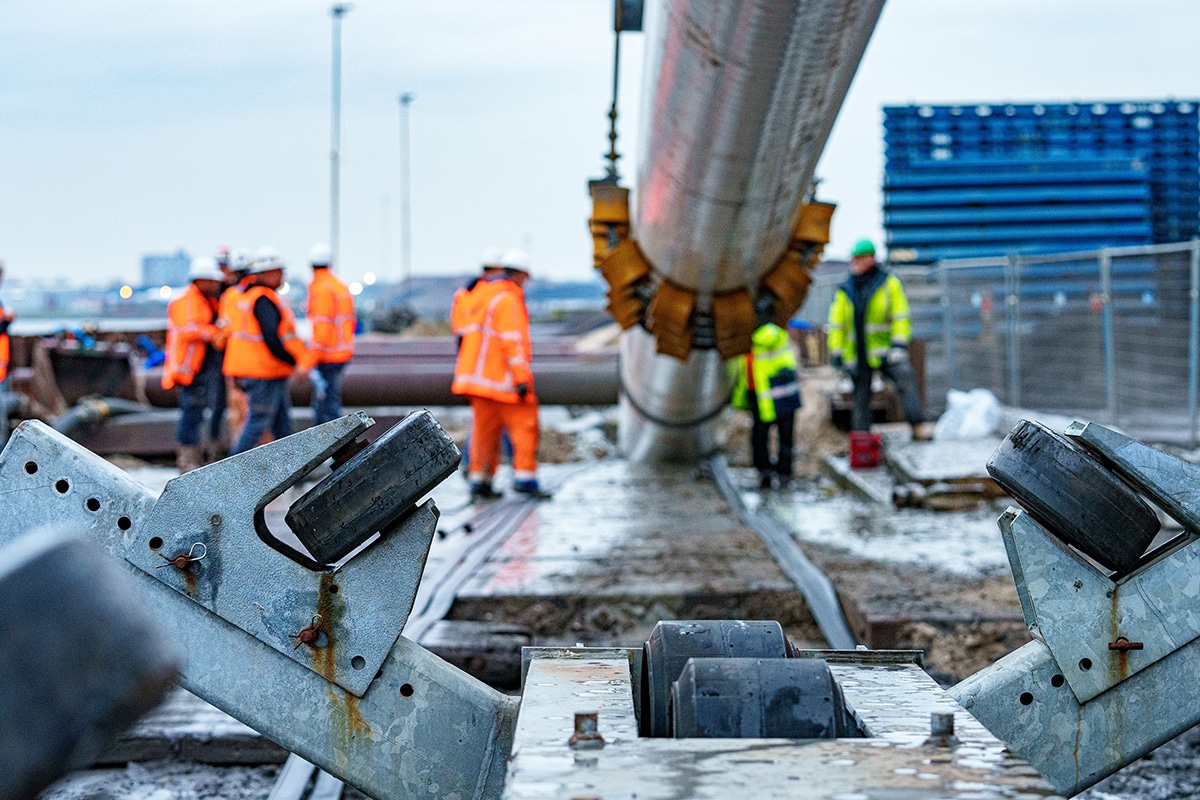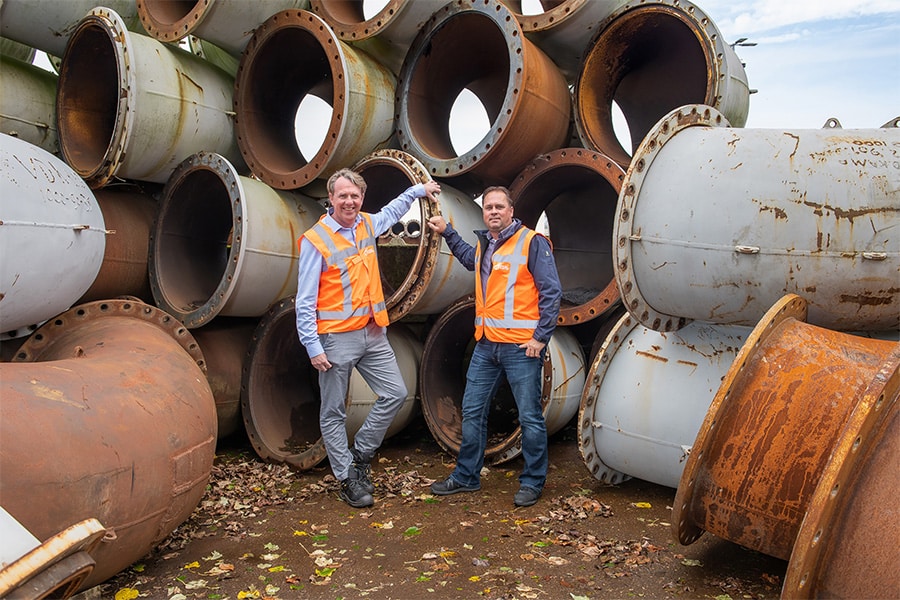
'On the outside of the Afsluitdijk, you can't see how much work is being done'
Sequence of technical challenges and milestones
The reinforcement and renewal of the Afsluitdijk is a project worthy of the name. It is a prime example of how to make a large structure future-proof in a sustainable way. Together with Wop Schat, project director Rijkswaterstaat, and Jan Jalving, project director Levvel EPC, we look back at the most important milestones but also look ahead to the work that is still visibly and invisibly on the schedule, such as the construction of the pumping station at Den Oever, one of the largest pumping stations in Europe.
"Many of the projects have now been completed," Wop says. "A lot of work has been done and we have achieved important milestones and completed projects. It hasn't always gone smoothly, but we are now running a steady course until completion at the end of 2026. Until the end of 2026, Levvel is still working on the pumping station at Den Oever and the new pumping stations. In total, we need at least another five years for the remaining projects. An important milestone is the completion of the reinforcement of the 32-kilometer-long Afsluitdijk, including the renewal of the A7. A highlight because various innovations have been applied to reinforce and renew the 32-kilometer-long dyke. Indeed, on the Wadden Sea side, the dike was raised by almost 2 meters and reinforced with innovative concrete blocks. The top of the dike has been reinforced with Quattroblocks, the bottom of the dike with Levvel blocks. The blocks break the waves when it storms hard. This fulfills the task of making the dike resistant to a superstorm that may occur once every 100,000 years."

Den Oever as an eye-catcher
The other task was to ensure that the dike has additional discharge capacity. "When the water in the Wadden Sea is lower than in the IJsselmeer, we use the sluices in the Afsluitdijk to drain (sluice) the excess water from the IJsselmeer. However, due to the rise in sea level we can drain less. In addition, the supply of water from rivers and surrounding areas to the IJsselmeer is increasing. This is the reason why we must therefore be able to discharge more water." To make this possible, construction is now in full swing at the pumping station at Den Oever. Here there will be two additional sluices and a pumping station with two pump groups. While the reinforcement and renewal of the Afsluitdijk is in itself a technical and logistical puzzle, it will remain so for the next five years. "After all, we are not only working on the pumping station and the sluices, but on the same 'postage stamp' at Den Oever the swing bridges also have to be replaced and the existing sluices renovated. So certainly logistically it remains a huge challenge for the time being." In May this year, the new pumping station was fitted with six gigantic pumps. An operation that went well thanks to months of preparation. It is expected that the pumps will be ready by the end of 2025, after which the new pumping stations will be built for a good year. "The entire complex at Den Oever has been the eye-catcher, because we are creating additional discharge capacity for the IJsselmeer with it. In the context of energy consumption, the basic principle is: we spout when we can, pump when we have to. The energy used by the sluices and pumps is generated sustainably with solar energy on and around the Afsluitdijk. This makes the Afsluitdijk an energy-neutral dike." The new culverts look spectacular. The existing culverts are a National Monument and must remain as they are in terms of appearance. But for the rest, they will be gutted and rebuilt inside. That, according to Wop, is at least as complex. "It's almost 100 years old and needs to move forward for at least another 50 years. So the technical challenges are certainly not off the table yet. The work on the Afsluitdijk also never stops, there are always new things coming up, like replacing the swing bridges and at some point there has to be major maintenance on the locks again and so on."

Hussar
In addition to the dyke reinforcement and the renewal of the A7, more projects have been completed, including the construction of two floodgates; one at Kornwerderzand and one at Den Oever, the passage under the dyke for the Vismigration River and the service area including the viewing balcony on the Wadden Sea side at the Vlietermonument. Projects that are still in the planning stages and are now in full swing, apart from the pumping station and the new sluices at Den Oever, include the construction of the Vismigration River and the restoration and expansion of the Vlietermonument. As far as Wop is concerned, these two certainly deserve attention. "The Vismigration River (see separate box) is special of its kind.
It is the first in the world of this size and complexity. It is the first time in the world that an artificial tidal river is constructed on the boundary of fresh and salt water. The restoration and modernization of the Kite Monument is also a feat, because you're building something in a water barrier dike. We are expanding it with a larger catering facility with a view of the IJsselmeer and a new footbridge will be built. The statue of Cornelis Lely, the man who designed the Afsluitdijk, will retain its prominent place."
Integral project in two respects
It is not only the milestones achieved that Wop is proud of. He would also like to highlight the cooperation with the contractors. "It is an enormously difficult job in which no one has been able to see ahead how things will turn out. Yet together we managed to keep the end goal in mind." Jan also wants to emphasize the good cooperation. "The pride is just in it. It's a grand, special and iconic project. What makes it special is that it is an integral project. First of all, it has different functions; it has to retain water, drain water and at the same time, shipping and road traffic must continue. During construction, these different functions must be safeguarded, which makes it complex. In addition, it is integral in terms of disciplines. It is a mix of civil engineering, hydraulic engineering, mechanical engineering, industrial automation and the relocation of cables and pipes. That also makes it fun especially now that the work is concentrated in Den Oever. That's where all these disciplines come together. We have therefore moved from multiple project teams to one integrated team, which is characteristic of the past year and a half. A lot of work has been done, visible and invisible. If you look at the Afsluitdijk as a whole, we have certainly achieved the spectacular simplicity that people often talk about. From the outside you can't see how much work has been done. During peak times, some 600 men are at work, inside and outside. On average, 300 men work on a day. It is these people who ensure that you and I keep our feet dry through their work on the Afsluitdijk, among other things. They have the knowledge and the experience."
Fish migration pier: one of a kind
A special part of the Afsluitdijk is the Vismigration River: a 4-kilometer-long meandering river for fish, right through the Afsluitdijk. An innovative project to reconnect the Wadden Sea and the IJsselmeer. Thanks to the Vismigration River, fish such as sea trout, salmon, eel and flounder will soon be able to migrate back and forth between Wadden Sea and IJsselmeer. As a result, the IJsselmeer water will become healthier and the fish population will recover. "It took years of research and study to determine what would be the best design for the river," says Wiepkje Elsinga, project manager of the Province of Fryslân. "After all, this is the first time in the world that an artificial tidal river of this size and complexity has been constructed on the boundary between fresh and salt water. It offers opportunities for some 200 locations worldwide that could benefit from this innovative approach. The Fish Migration River is of historic significance for the Afsluitdijk and our province, for our nature and tourism. The Netherlands is showing here that coastal safety, freshwater conservation and nature restoration can go together. We are quite proud of that."
Circular approach
What is also special is the circular approach. Many materials released from the dike reinforcement have been reused in the construction and construction of the Vismigration Pier. "For example, we used released sand from the work in Den Oever. We were also able to reuse materials released from the temporary working island, which was needed to make the passage in the Afsluitdijk, as well as the broken stone that was released when the dike was reinforced. And from nature reserve Makkumer Noordwaard we transplanted reeds that would otherwise be destroyed. All in all, so far we have made the various subareas of the Vismigration Pier almost entirely with materials, sourced from the immediate area."
Every step feels like a victory
Wiepkje appreciates the mutual cooperation between all parties involved. And there are quite a few: the client is the province of Fryslân. The initiative for the Vismigration Pier comes from the Waddenvereniging, It Fryske Gea, Sportvisserij Nederland, NetVISwerk and coalition het Blauwe Hart Natuurlijk. Construction consortium Levvel (BAM, Van Oord, Rebel and Invesis) made the passage in the Afsluitdijk for Rijkswaterstaat. Contractor combination IJsselmeerwerken VOF (BAM, Van Oord) is making the contours on both sides of the Afsluitdijk and contractor Boskalis is making the unique zigzagging river. "This is the first time we are developing and building such a project. Every step we take together feels like a victory. We are therefore looking forward to the end of 2025, when the first fish swim through the Vismigration River!"
About the Afsluitdijk
The Afsluitdijk has protected large parts of the Netherlands from flooding from the sea since 1932. But the dike was in need of renewal. It does not meet current legal standards for water safety. Moreover, the climate is changing. As a result, the sea level is rising and there will be more frequent extreme weather events. The dike must continue to protect us from flooding under changing conditions. The renewal of the dike is an extremely special and also complex project that is expected to take eight years in total. In total, there are ten subprojects that will start at different times. Construction consortium Levvel (BAM, Van Oord, Rebel and Invesis) and Rijkswaterstaat are working on these subprojects. The planned completion of the project is in 2026. The renovated Afsluitdijk will then meet the statutory standards for water safety until at least 2050. You can read more information and news at www.deafsluitdijk.nl.




